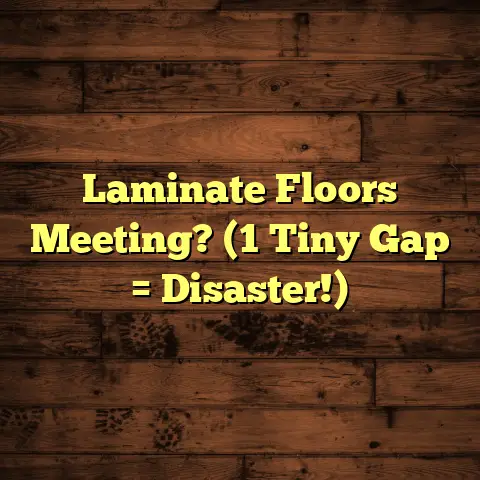Can Mold Grow on Concrete Floors? (5 Slab Secrets!)
(5 Slab Secrets!)
It’s your friendly neighborhood flooring contractor, ready to dive deep into the nitty-gritty of concrete floors and a topic nobody likes to talk about: mold.
Concrete floors, right? They’re everywhere! From sleek, polished surfaces in modern homes to the rough, utilitarian slabs in our garages and basements.
I’ve seen it all in my years of installing, repairing, and yes, even battling mold on these surfaces.
Exploring Textures of Concrete Floors
Let’s take a moment to appreciate the sheer versatility of concrete.
Think about it: you can have a concrete floor that’s as smooth as glass, reflecting light and giving a contemporary vibe.
Or, you can opt for a textured, distressed finish that screams rustic charm.
The possibilities are endless!
I’ve worked on projects where we stained concrete to mimic the look of expensive tile or even wood.
It’s incredible what you can achieve with this versatile material.
But here’s the thing: while concrete is tough and generally low-maintenance, it’s not invincible.
And that brings us to the uncomfortable truth: mold can grow on concrete floors.
Now, you might be thinking, “Wait a minute! Concrete is just rock and cement. What’s there for mold to eat?”
That’s a fair question, and we’ll get to the bottom of it.
But first, let’s set the stage.
Have you ever noticed a musty smell in your basement, especially after a heavy rain?
Or maybe you’ve seen a dark, fuzzy patch on the floor near a damp wall?
These could be signs of mold, and ignoring them can lead to bigger problems down the road.
So, why is this happening?
What conditions allow mold to thrive on something as seemingly inhospitable as a concrete floor?
And, most importantly, what can you do about it?
That’s what we’re going to explore in this article.
I’m going to share some insider secrets, based on my years of experience, to help you understand, identify, and prevent mold growth on your concrete floors.
Ready to get started? Let’s dive in!
Section 1: Understanding Mold and Its Growth Conditions
Okay, let’s get down to the basics.
What exactly is mold?
In simple terms, mold is a type of fungus.
It’s everywhere around us, both indoors and outdoors.
There are thousands of different species, and they play a crucial role in breaking down organic matter in the environment.
But when mold starts growing in our homes, that’s when it becomes a problem.
Some common types of mold you might encounter include:
-
Aspergillus: Often found in air conditioning systems.
-
Cladosporium: Can grow on both living and dead plants.
-
Penicillium: Commonly found in soil, food, and indoor air.
-
Stachybotrys chartarum (Black Mold): This is the one everyone worries about, and it’s often associated with water damage.
So, what does mold need to grow?
Think of it like a plant: it needs certain conditions to thrive.
The three main ingredients for mold growth are:
-
Moisture: This is the big one. Mold needs water to survive. Leaks, humidity, condensation – all of these can provide the moisture mold craves.
-
Organic Material: Mold needs something to eat. This could be anything from dust and dirt to wood, paper, or even certain types of paint.
-
Suitable Temperatures: Mold generally prefers temperatures between 40°F and 100°F (4°C and 38°C), which, unfortunately, is the typical range for most homes.
Now, let’s address the elephant in the room: concrete.
Concrete itself isn’t organic, so it’s not a food source for mold.
But here’s the catch: concrete is porous, meaning it has tiny holes and cracks that can trap moisture.
And that moisture, combined with organic material (like dust or spilled food), can create the perfect environment for mold to take hold.
Think of it like this: the concrete is the hotel, and the moisture and organic material are the free buffet that attracts the mold.
I’ve seen countless cases where a seemingly clean concrete floor was actually harboring a hidden mold colony beneath the surface.
It’s a sneaky problem, but understanding the science behind it is the first step in preventing it.
Section 2: The Science Behind Concrete and Moisture
Alright, let’s get a little nerdy and talk about the science of concrete and moisture.
I know, it might not sound like the most thrilling topic, but trust me, it’s crucial to understanding how mold can grow on concrete floors.
So, what makes concrete so susceptible to moisture?
Well, it all comes down to its porosity.
Concrete is essentially a mix of cement, water, and aggregates (like sand and gravel).
As the concrete hardens, the water evaporates, leaving behind tiny pores and capillaries throughout the material.
These pores act like little sponges, soaking up any moisture that comes their way.
Now, you might be thinking, “Okay, so concrete can absorb water. Big deal.”
But here’s where it gets interesting.
When water gets trapped inside these pores, it can create a consistently damp environment that’s perfect for mold growth.
And it’s not just about absorption.
Concrete can also be affected by condensation.
Think about a cold glass of water on a hot day.
The moisture in the air condenses on the surface of the glass, right?
The same thing can happen with concrete floors, especially in basements or other areas with poor ventilation.
When warm, humid air comes into contact with a cool concrete surface, condensation can form, leaving the floor damp and vulnerable to mold.
But wait, there’s more!
Let’s talk about hydrostatic pressure.
This is a fancy term for the pressure exerted by groundwater on a structure.
If your concrete floor is in contact with the ground (like in a basement), groundwater can seep through the concrete due to this pressure.
This is especially common in areas with high water tables or poor drainage.
I’ve seen cases where hydrostatic pressure caused water to literally bubble up through the concrete floor, creating a swamp-like environment that was a mold paradise.
According to the American Society of Civil Engineers (ASCE), hydrostatic pressure can exert significant force on underground structures, leading to water intrusion and structural damage.
So, to recap: concrete is porous, susceptible to condensation, and can be affected by hydrostatic pressure.
All of these factors can contribute to moisture accumulation, creating a breeding ground for mold.
It’s a complex problem, but understanding these scientific principles is essential for tackling it effectively.
Section 3: Identifying Mold Growth on Concrete Floors
Alright, now that we know why mold can grow on concrete floors, let’s talk about how to identify it.
Early detection is key to preventing serious mold problems.
The sooner you spot the signs, the sooner you can take action to address the issue.
So, what should you be looking for?
The most obvious sign of mold is visual discoloration.
This could be anything from small, dark spots to large, fuzzy patches.
The color of the mold can vary depending on the species.
You might see:
-
Black mold: Often appears as black or dark green splotches.
-
Green mold: Can range from light green to dark, almost blackish-green.
-
White mold: Can look like a powdery or cottony substance.
-
Brown mold: Often appears as brownish or tan stains.
But don’t rely solely on visual cues.
Sometimes, mold can be hidden beneath the surface of the concrete or behind walls.
That’s why it’s important to use your other senses, too.
One of the most telltale signs of mold is a musty odor.
It’s a distinctive smell that’s often described as earthy, stale, or damp.
If you notice a musty smell in your basement or near your concrete floor, even if you don’t see any visible mold, it’s worth investigating further.
Another thing to look for is changes in the texture of the concrete.
Mold can sometimes create a fuzzy or slimy texture on the surface of the floor.
If you run your hand over the concrete and it feels different in certain areas, that could be a sign of mold growth.
Here’s a quick checklist of things to look for when inspecting your concrete floor for mold:
-
Visual Discoloration: Dark spots, fuzzy patches, or stains.
-
Musty Odor: A distinctive, earthy smell.
-
Textural Changes: Fuzzy or slimy areas.
-
Water Stains: Evidence of past or present moisture problems.
-
Allergic Reactions: If you or your family members experience allergy symptoms (like sneezing, coughing, or skin rashes) when you’re in a certain area, it could be due to mold.
Remember, early detection is crucial.
If you suspect you have mold, don’t ignore it.
The longer you wait, the worse the problem will get.
Mold can spread quickly, causing structural damage to your home and potentially leading to health problems.
According to the Environmental Protection Agency (EPA), mold exposure can cause a variety of health effects, including:
- Nasal congestion
- Eye irritation
- Wheezing
- Skin irritation
In severe cases, mold exposure can even lead to respiratory infections or asthma attacks.
So, take mold seriously.
If you think you have a problem, take action to address it as soon as possible.
Section 4: The Five Slab Secrets: How Mold Thrives on Concrete Floors
Alright, let’s get to the heart of the matter.
I’m going to share five “slab secrets” that reveal how mold can thrive on concrete floors.
These are the hidden factors that often go unnoticed but can create the perfect storm for mold growth.
Secret 1: Hidden Water Sources
This is the most common culprit.
Mold needs moisture to survive, and hidden water sources can provide a constant supply of it.
Think about it: how many potential water sources are lurking in your home?
-
Plumbing Leaks: A leaky pipe, a dripping faucet, or a running toilet can all introduce moisture to your concrete floor.
-
Condensation from HVAC Systems: Air conditioning units and dehumidifiers can produce condensation, which can drip onto the floor if not properly drained.
-
Groundwater Seepage: As we discussed earlier, hydrostatic pressure can cause groundwater to seep through the concrete, especially in basements.
I once worked on a project where the homeowner had a persistent mold problem in their basement.
We searched high and low for the source of the moisture, but we couldn’t find anything.
Finally, we discovered a tiny pinhole leak in a pipe behind a wall.
It was barely noticeable, but it was enough to keep the concrete floor constantly damp, leading to significant mold growth.
Secret 2: Insufficient Drainage
Proper drainage is essential for preventing water from pooling around and under your concrete slab.
If your landscaping slopes towards your foundation, or if your gutters are clogged, rainwater can accumulate near the concrete, increasing the risk of moisture intrusion.
I always advise homeowners to make sure their landscaping slopes away from their foundation and to keep their gutters clean and clear.
It’s a simple step that can make a big difference in preventing water damage and mold growth.
Secret 3: Inadequate Ventilation
Mold loves stagnant air.
If you have poor ventilation in your basement or other areas with concrete floors, humidity can build up, creating a moist environment that’s perfect for mold to thrive.
Make sure you have adequate airflow in these areas.
Open windows when the weather permits, use fans to circulate the air, and consider installing a dehumidifier if necessary.
Secret 4: Temperature Fluctuations
Changes in temperature can lead to condensation on concrete surfaces.
As we discussed earlier, when warm, humid air comes into contact with a cool concrete floor, condensation can form, leaving the floor damp and vulnerable to mold.
This is especially common in basements, which tend to be cooler than the rest of the house.
To minimize condensation, try to keep the temperature in your basement as consistent as possible.
You can also insulate your concrete floor to help regulate its temperature.
Secret 5: Organic Residue
Even though concrete itself isn’t a food source for mold, organic residue can provide the nutrients that mold needs to grow.
Dirt, dust, leaves, spilled food, and even certain types of paint can all serve as food for mold.
That’s why it’s important to keep your concrete floors clean and free of debris.
Regularly sweep or vacuum your floors, and promptly clean up any spills.
You should also avoid using organic-based paints or sealants on your concrete floors, as these can provide a food source for mold.
So, there you have it: the five slab secrets that reveal how mold can thrive on concrete floors.
By understanding these hidden factors and taking steps to address them, you can significantly reduce your risk of mold growth.
Section 5: Case Studies and Real-Life Examples
Let’s bring these concepts to life with some real-world examples.
I’ve seen firsthand how these “slab secrets” can play out in different scenarios.
Case Study 1: The Leaky Laundry Room
I was called to a home with a persistent mold problem in the laundry room, which had a concrete floor.
The homeowners had tried everything to get rid of the mold, but it kept coming back.
After a thorough inspection, I discovered a slow leak in the washing machine’s drain hose.
The leak was so small that it was barely noticeable, but it was enough to keep the concrete floor constantly damp.
This, combined with the lint and detergent that accumulated on the floor, created the perfect environment for mold growth.
Quote from Homeowner: “We were so frustrated! We cleaned and cleaned, but the mold just kept coming back. We never suspected the washing machine hose was the problem.”
Outcome: We replaced the leaky drain hose and thoroughly cleaned the concrete floor with a mold-killing solution.
We also recommended that the homeowners install a dehumidifier in the laundry room to help keep the humidity levels down.
The mold problem was resolved, and the homeowners were finally able to breathe easy.
Case Study 2: The Basement with Poor Drainage
I inspected a basement with extensive mold growth on the concrete floor.
The homeowner explained that the basement had always been damp, especially after heavy rains.
I quickly realized that the landscaping around the house sloped towards the foundation, causing rainwater to pool near the concrete slab.
This, combined with clogged gutters, led to significant water intrusion into the basement.
Quote from Homeowner: “We knew we had a drainage problem, but we didn’t realize it was causing the mold!”
Outcome: We regraded the landscaping to slope away from the foundation and cleaned out the gutters.
We also installed a sump pump in the basement to help remove any excess water.
After addressing the drainage issues and cleaning the mold, the basement was finally dry and mold-free.
Case Study 3: The Unventilated Bathroom
I was asked to investigate a bathroom with mold growing on the concrete subfloor beneath the tile.
The bathroom had no windows and a poorly functioning exhaust fan.
This lack of ventilation led to high humidity levels, especially after showers.
The moisture seeped through the grout and into the concrete subfloor, creating a breeding ground for mold.
Quote from Homeowner: “We never used the exhaust fan because it was so noisy. I guess that was a mistake!”
Outcome: We replaced the old exhaust fan with a new, quieter model and thoroughly cleaned the mold from the concrete subfloor.
We also recommended that the homeowners use the exhaust fan every time they showered to help reduce humidity levels.
These case studies illustrate the importance of addressing the underlying causes of mold growth.
Simply cleaning the mold without fixing the moisture problem is like putting a bandage on a wound that needs stitches.
It might provide temporary relief, but the problem will eventually come back.
Conclusion: Final Thoughts on Mold and Concrete Floors
Well, we’ve covered a lot of ground in this article!
We’ve explored the textures of concrete floors, delved into the science of mold growth, and uncovered five “slab secrets” that reveal how mold can thrive on these surfaces.
The key takeaway is this: while concrete is a durable and versatile flooring option, it’s not immune to mold.
Moisture is the enemy, and it’s crucial to identify and address any sources of moisture in your home.
Regularly inspect your concrete floors for signs of mold, and take action to address any problems as soon as possible.
Remember, early detection is key to preventing serious mold issues.
By being proactive and vigilant, you can protect your home and your health.
I hope this article has been helpful and informative.
If you have any questions or experiences related to mold and concrete flooring, please share them in the comments below.
I’m always happy to hear from my readers and learn from your experiences.
Thanks for reading, and happy flooring!





